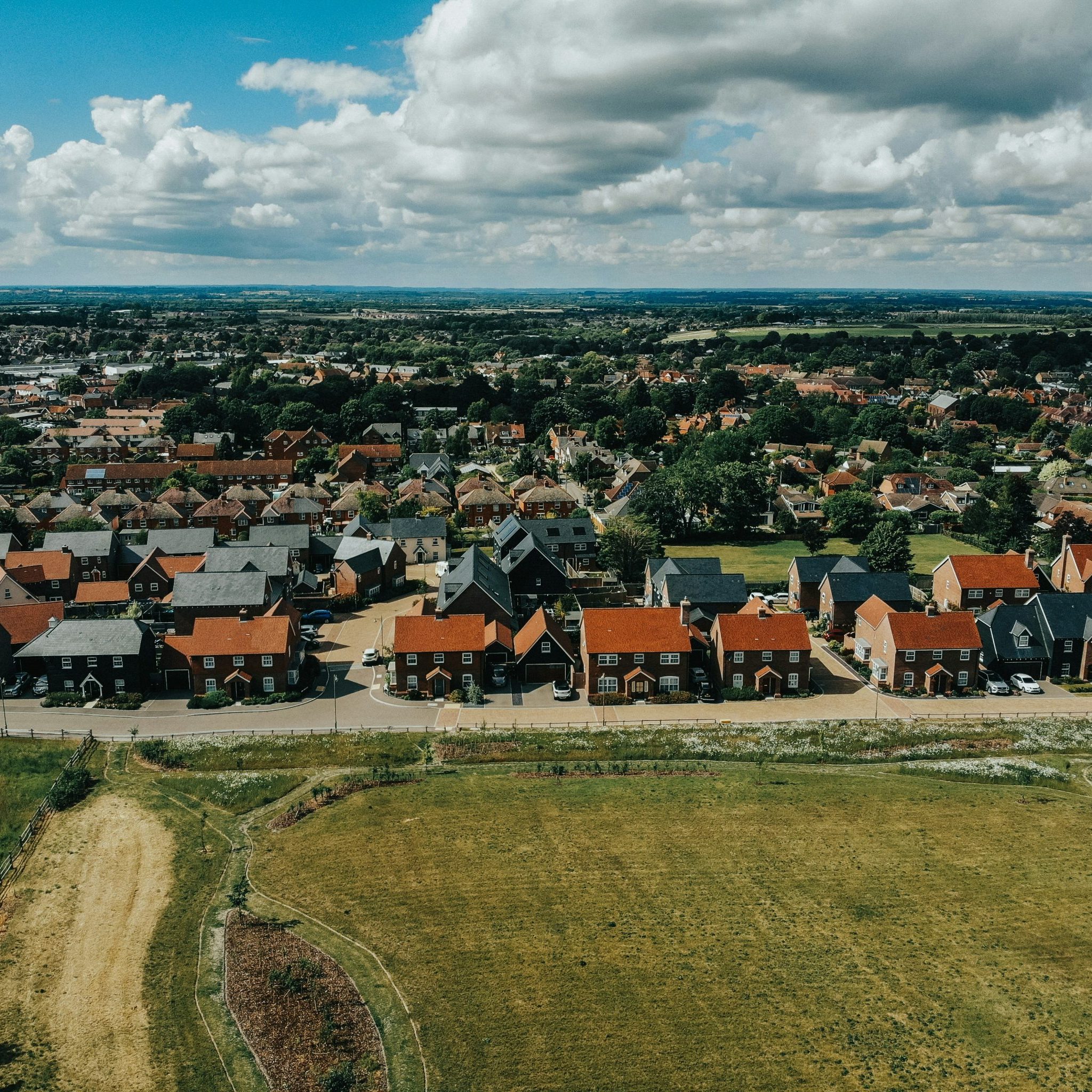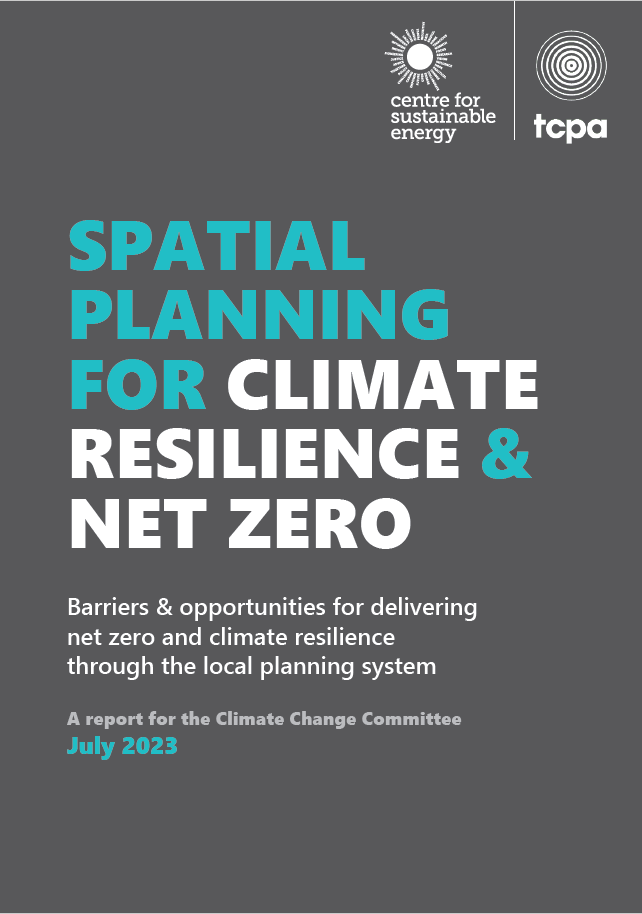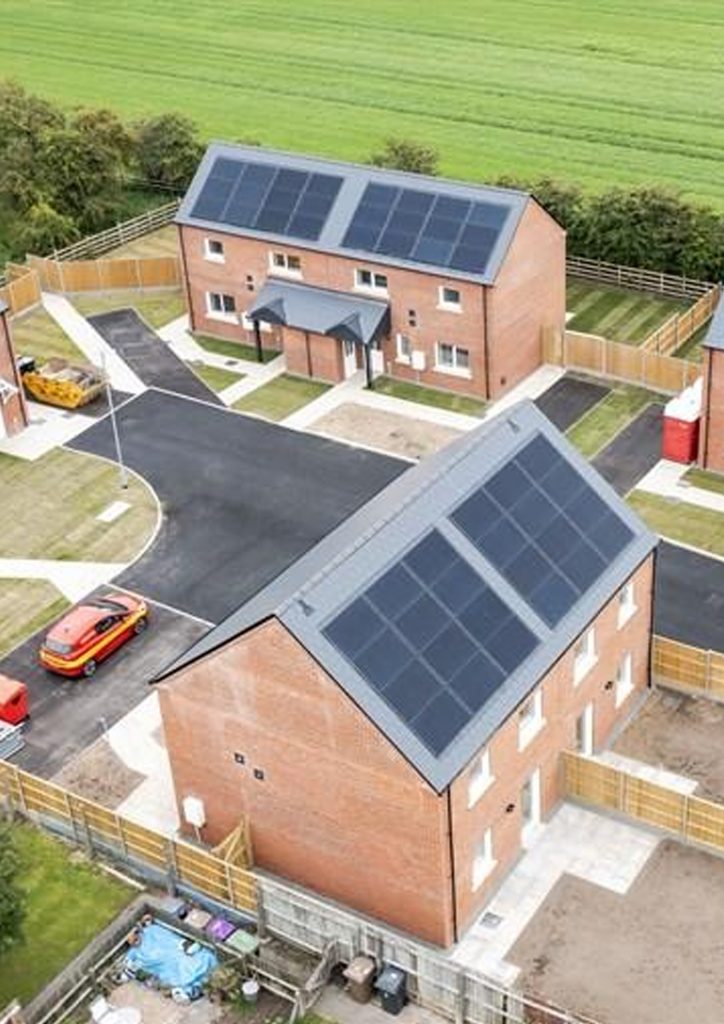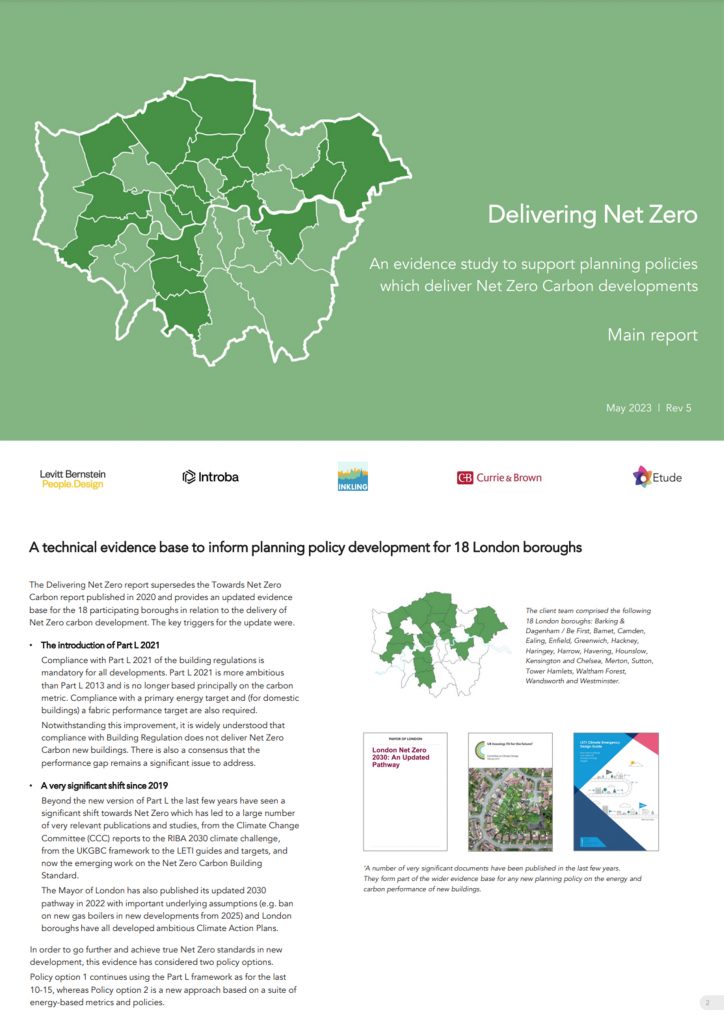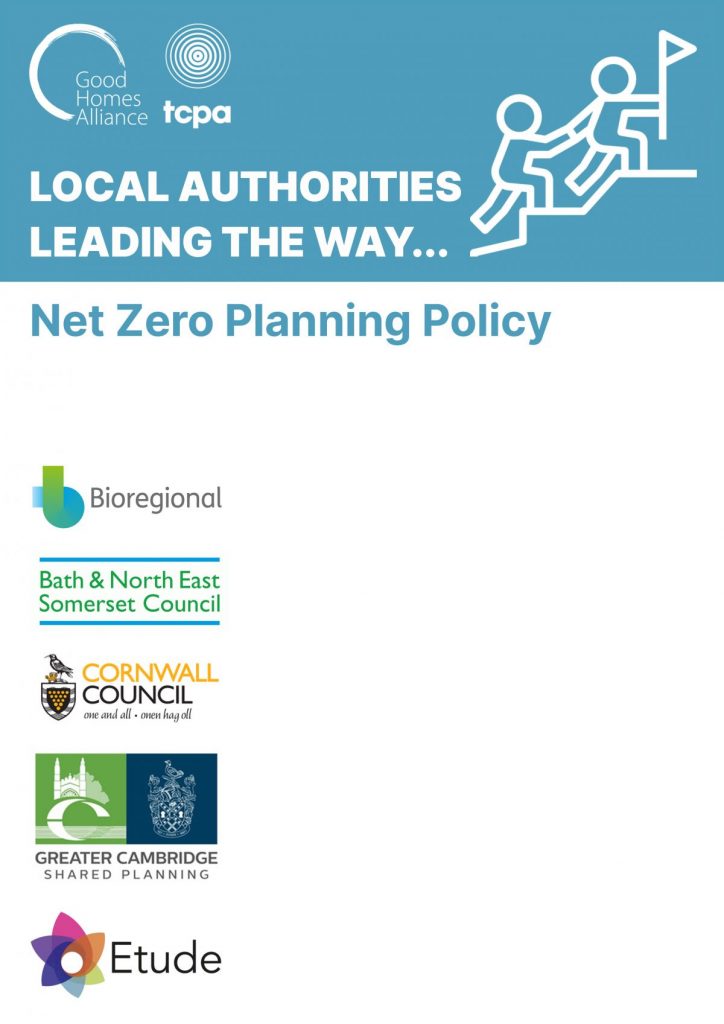NET ZERO PLANNING POLICY

UPDATE! A Written Ministerial Statement (WMS) published 13/12/23 has created confusion for local planning authorities on their ability to set sustainability standards above and beyond national regulations.
Alongside TCPA and others, GHA is engaging with DLUHC to seek clarity on the WMS and has signed a joint letter to the Secretary of State (21/02/24) to outline our concerns. A response from Baroness Swinburne (25/03/24) stated “that local plan-makers retain the ability to set energy efficiency standards at the local level that go further than the Building Regulations.” which seems to contradict the WMS.
To support and inform LPAs, TCPA, supported by GHA and other progressive organisations, will:
- Publish updated technical guidance for local authorities.
- Author a blog post, highlighting the outcomes of legal challenges in regard to decisions made by the Planning Inspectorate referencing a 2015 WMS (see Salt Cross, Lancaster), and seek to provide clarity on the 2023 WMS to provide reassurance for LPAs who are seeking to set ambitious net zero policies in their updated local plans.
Local Authorities can, and are, setting higher sustainability standards in their planning policies. This resource sets out some practical steps for the adoption and implementation of progressive policies, including leading edge case studies, timeline and actions, and resources.
This resource hub has been created and is managed by the Good Homes Alliance, with the support of consultants and GHA members, Bioregional and Etude, alongside GHA partners Passivhaus Trust and Town and Country Planning Association.





Table of Contents
Latest news
Adopted Local Plans with higher energy efficiency standards

Cornwall Council
Cornwall Council continues to work towards becoming carbon neutral by 2030. The council is leading by example encouraging all other agencies, businesses, residents and visitors to Cornwall to help take this huge step.
Cornwall adopted their new Climate Emergency DPD in February 2023, with a clear set of Energy Use Intensity (EUI) targets going above and beyond building regulations for all new residential developments.
Read the Climate Emergency Development Plan Document here.
As members of the collaborative Good Homes Alliance Vanguard Network of Local Authorities, Cornwall Council show their leadership and commitment to the climate emergency.
Policy SEC1 – Sustainable Energy and Construction
Development proposals will be required to demonstrate how they have implemented the principles and requirements set out in the policy below.
1 The Energy Hierarchy
All proposals should embed the Energy Hierarchy within the design of buildings by prioritising fabric first, orientation and landscaping in order to minimise energy demand for heating, lighting and cooling. All proposals should consider opportunities to provide solar PV and energy storage.
2b New Development – Residential
Residential development proposals will be required to achieve Net Zero Carbon and submit an ‘Energy Statement’ that demonstrates how the proposal will achieve:
- Space heating demand less than 30kWh/m2/annum;
- Total energy consumption less than 40kWh/m2/annum; and
- On-site renewable generation to match the total energy consumption, with a preference for roof-mounted solar PV.
Where the use of onsite renewables to match total energy consumption is demonstrated to be not technically feasible (for example with apartments) or economically viable renewable energy generation should be maximised as much as possible; and/or connection m a d e to an existing or proposed low carbon district energy network; or where this is not possible the residual energy (the amount by which total energy demand exceeds the renewable energy generation) is to be offset by a contribution to Cornwall Council’s Offset Fund.
Where economic viability or technical constraints prevent policy compliance, proposals should first and foremost strive to meet the space heating and total energy consumption thresholds. Proposals must then benefit as much as possible from renewable energy generation and/or connection to an existing or proposed low carbon district energy network. As a last resort, any residual energy is to be offset by a contribution to Cornwall Council’s Offset Fund, as far as economic viability allows.
While this policy does not require the application of these standards to reserved matters applications that relate to outline planning permissions that predate the adoption of this climate Emergency DPD, developers are encouraged to apply these standards on a voluntary basis, where it is feasible to do so and not within breach of existing permissions.
3 Existing Buildings
Significant weight will be given to the benefits of development resulting in considerable improvements to the energy efficiency and reduction in carbon emissions in existing buildings.
Proposals that help to increase resilience to climate change and secure a sustainable future for historic buildings and other designated and non-designated heritage assets will be supported and encouraged where they:
- conserve (and where appropriate enhance/better reveal) the design, character, appearance and historical significance of the building; or
- facilitate their sensitive re-use where they have fallen into a state of disrepair or dereliction (subject to such a re-use being appropriate to the specific heritage asset).
4 Domestic and Non-Residential Renewables
The Council will support domestic and non-residential renewables such as solar panels where they require planning permission. Proposals should minimise visual impact wherever possible.
Proposals affecting heritage assets, including their settings, shall seek to avoid and minimise negative impacts on their significance and conserve the character of historic townscapes, landscapes and seascapes.
Read the full policy on page 39 of the Climate Emergency DPD
In 2019 Cornwall Council Declared a climate emergency.
Februaruy 2023, Climate Emergency DPD adopted.
In recognition of the Climate Emergency and the very real need to meet net zero as soon as possible, Cornwall Council has collaborated with GHA member and sustainability consultants, Etude, alongside the South West Energy Hub, to carry out energy modelling work tailored specifically to Cornwall. Cornwall Council also worked very closely with Bath and NE Somerset Council.
- AECOM were appointed to carry out the Sustainability appraisal.
- Three Dragons were appointed to carry out the viability report.
- You can see all of the submission documents including those referenced above here.
Policy SEC1 (the net zero policy) has been implemented since June 2023, a year during which Cornwall Council processed the most applications for dwellings of any planning authority in England and approval rates have remained high. The use of the offsetting by exception route (for where there are technical limitations) has been negligible. The success of the policy has been helped by training, guidance and support given to applicants and officers. A specialist officer supports the application of the policy including through pre-application advice.
Policy SEC1 is a key policy within Cornwall Council’s Climate Emergency DPD which won “Best Plan” and “Best in Region” at the 2024 South West RTPI Awards. The award judges recognised the exemplary standards for energy performance and construction as well as their transferability to other locations, affordability and deliverability. https://www.rtpi.org.uk/find-your-rtpi/rtpi-english-regions/rtpi-south-west/south-west-awards-for-planning-excellence/south-west-2024-results/best-plan-2024/

Bath and North East Somerset Council
In order to address a range of urgent issues in B&NES, including the climate and ecological emergency declarations, the Council has implemented a partial update of the Core Strategy and Placemaking Plan (which together comprise the Local Plan).
B&NES adopted a Local Plan Partial Update in January 2023, with a clear set of Energy Use Intensity (EUI) targets going above and beyond building regulations for all new residential developments.
Read the Local Plan Partial Update here.
Policy SCR6 – Sustainable Construction Policy for New Build Residential Development
New Build Residential Development
New build residential development will be required to meet the standards set out below. 31 New build residential development will aim to achieve zero operational emissions by reducing heat and power demand then supplying all energy demand through onsite renewables. Through the submission of an appropriate energy assessment, having regard to the Sustainable Construction Checklist SPD, proposed new residential development will demonstrate the following;
- Space heating demand less than 30kWh/m2/annum;
- Total energy use less than 40kWh/m2/annum; and
- On site renewable energy generation to match the total energy use, with a preference for roof mounted solar PV
- Connection to a low- or zero-carbon District heating network where available
Major residential development
In the case of major developments where the use of onsite renewables to match total energy consumption is demonstrated to be not technically feasible (for example with apartments) or economically viable, renewable energy generation should be maximised and the residual on site renewable energy generation (calculated as the equivalent carbon emissions) must be offset by a financial contribution paid into the Council’s carbon offset fund where the legal tests set out in the Community Infrastructure Regulations are met.
In 2019 B&NES declared a Climate Emergency.
January 2023, Local Plan Partial Update adopted.
Currie & Brown and GHA members Etude did the energy review and modelling.
B&NES worked closely with Conrwall Council, with whom they shared an evidence base.

Central Lincolnshire
The three local planning authorities that comprise Central Lincolnshire, the City of Lincoln and the districts of North Kesteven and West Lindsey, have recognised an urgent need for action in response to climate change.
The Local Plan Review includes five ‘themes’ to reduce energy consumption, increase renewable energy generation, prevent the loss of carbon sinks, facilitate the transition to a net-zero carbon lifestyle and adapt to climate change.
Read the Central Lincolnshire Local Plan here.
See all news and documents relating to the Central Lincolnshire Local Plan here.
Policy S7 – Reducing Energy Consumption – Residential Development
Unless covered by an exceptional basis clause below, all new residential development proposals must include an Energy Statement which confirms in addition to the requirements of Policy S6 that all such residential development proposals:
1. Can generate at least the same amount of renewable electricity on-site (and preferably on-plot) as the electricity they demand over the course of a year, such demand including all energy use (regulated and unregulated), calculated using a methodology proven to accurately predict a building’s actual energy performance; and
2. To help achieve point 1 above, target achieving a site average space heating demand of around 15-20kWh/m2/yr and a site average total energy demand of 35 kWh/m2/yr, achieved through a ‘fabric first’ approach to construction. No single dwelling unit to have a total energy demand in excess of 60 kWh/m2/yr, irrespective of amount of on-site renewable energy production. (For the avoidance of doubt, ‘total energy demand’ means the amount of energy used as measured by the metering of that home, with no deduction for renewable energy generated on site). The Energy Statement must include details of assured performance arrangements. As a minimum, this will require:
a) The submission of ‘pre-built’ estimates of energy performance; and
b) Prior to each dwelling being occupied, the submission of updated, accurate and verified ‘as built’ calculations of energy performance. Such a submission should also be provided to the first occupier (including a Non-Technical Summary of such estimates).
Weight will be given to proposals which demonstrate a deliverable commitment to on-going monitoring of energy consumption, post-occupation, which has the effect, when applicable, of notifying the occupier that their energy use appears to significantly exceed the expected performance of the building, and explaining to the occupier steps they could take to identify the potential causes of such high energy use.
In 2019 Central Lincolnshire declared a Climate Emergency.
April 2023, Local Plan adopted.
The Central Lincolnshire Joint Strategic Planning Committee appointed the following organisations to help develop its response to the climate emergency. They provided the region’s local authorities with an evidence base for creating a net zero carbon Local Plan.
- Bioregional – Environmental charity and GHA member with experience in all -round sustainability, sustainable construction and policymaking from local to international level
- Etude – Engineering firm with expertise in energy, construction and architecture
- Currie & Brown – Quantity surveyors/cost consultants and GHA member with experience of advising central and local government on cost implications of the transition to low carbon
The climate change evidence documents can be seen under the climate change tab here.

Merton
To make Merton a more environmentally sustainable place and net-zero carbon by 2050 [1], Merton Council aims to reduce greenhouse gas emissions and increase local resilience to the impacts of a changing climate through sustainable design.
Read the Merton Local Plan here.
Policy CC2.3 Minimising Energy Use
- Merton Council will require all proposed development within the borough to demonstrate that they have made the fullest contribution to minimising energy use through energy efficiency on site.
- This will be achieved by requiring: All development resulting in the creation of 1 or more dwellings or 500sqm or more nonresidential GIA
- To demonstrate how energy demand, including regulated and unregulated uses, has been minimised on site through passive measures and by maximising the efficiency of building form, fabric and systems.
- To disclose the anticipated Energy Use Intensity9 at design and pre-occupation stage. All new build development resulting in the creation of 1 or more residential unit or 500sqm or more non-residential GIA
- To demonstrate compliance with the following relevant fabric efficiency targets*:
Type of Development | Zero Carbon Hub Interim FEES until 31 December 2022 | Zero Carbon Hub Full FEES from 01 January 2023 to 31 December 2024 | Space Heating Demand Target from 01 January 2025 |
Blocks of flats and midterrace houses | <43kWh/m2/yr | <39kWh/m2/yr | <15kWh/m2/yr |
Semi-detached, end of terrace and detached houses | <52kWh/m2/yr | <46kWh/m2/yr | <20kWh/m2/yr |
| Non-residential development | <15kWh/m2/yr |
Adopted November 2024
The following organisations were noted to have contributed to local plan, in particular to the delivery of net zero
Implementing ambitious policies - timeline and actions
Below is a timeline for creating and implementing planning policies above the minimum required by Part L, based on the experience of Cornwall Council, who’s Climate Emergency Development Plan Document (DPD) was formally adopted in February 2023, with supporting documents from B&NES (Local Plan Partial Update), Greater Cambridge (Local Plan) and Central Lincolshire (Local Plan).
All of the above are avenues within the Local Plan in which local authorities are able to amend and introduce ambitious net zero policies.
The timeline lays out 7 steps, from inception, to implementation, and training. It includes key information with some examples and resources.
Over 75% of councils have declared a climate emergency. Cornwall dedclared a climate emergency on 22 January 2019.
Cornwall Council’s Climate Change Action Plan was approved on 24 July 2019, this includes the production of a DPD. An example of statement can be seen below from when they initiated their Climate Emergency DPD.
‘Cornwall declared a climate emergency in 2019. Recognising that all services across the Council would have a part to play. New planning policies are a step towards improving Cornwall’s housing and infrastructure. Helping to plan for a Cornwall that our children and grandchildren can live, work and thrive in.
This plan impacts how places grow and change, whilst sitting alongside Government legislation. The policies will help to protect and shape the future of Cornwall by adding detail to the Cornwall Local Plan (2016). The aim is to address the impacts of climate change with flexible policies that can keep up with changes in technology.’
You can see Cornwall’s notice of Submission of the Climate Emergency Development Plan here.
Before submission three consultations need to take place. Below are some examples from each three stages.
1: Initial consultation.
- Cornwall – scoping consultation – this included a questionnaire. See the Climate Emergency Development Plan Document Scoping Feedback (summary) here.
- Greater Cambridge – ‘The First Conversation’ consultation. See the document here.
2: Pre-submission stage consultation – intended to set out the draft policies in and invite comments on the content.
- See Cornwall’s Climate Emergency Development Plan Document Draft Policies consultation here.
3: Second pre-submission stage consultation.
- See the B&NES Local Plan Partial Update (LPPU) public consultation web page here.
Following the consultations and revision, the submission documents and information can be submitted to the Secretary of State (reg 22).
You can see Central Lincolnshire’s Local Plan Regulation 22(1)(c) Consultation Statement here.
The submission must be robust, with supporting evidence (See practical steps to implement ambitious planning policies below). All submitted documents are available to view on the mentioned council’s websites. Links below.
- Cornwall
- B&NES
- Cambridge (First proposals)
- Central Lincolnshire
The DPD goes under independent examination. There is a hearing and the inspector publishes a report.
Read the ‘Report on the Examination of the Cornwall Council Climate Emergency Development Plan Document’ here.
Cornwall’s examination hearing focused on:
- The principle of LPAs setting energy standards (PPG / Written Ministerial Statement)
- written and verbal case
- Government FHS consultation response and email confirmation
- Costs / viability
- Headroom in most typologies
- Saves homeowners through bills in the long-run so adds value
- Will be requiring viability appraisal to demonstrate schemes are going as far as they can where full compliance is not possible
- Supply chains (ASHP)
- Policy needed to drive investment in supply
- Getting ahead of the rush
- BEIS research indicated supply is unconstrained
- Builders merchants were positive and gearing up
The DPD will either be rejected or formally adopted, with a later date for implementation. In Cornwall’s case, it was adopted on 21 February 2023, just over 4 years after declaration of climate emergency.
There are is some uncertainty on the ability of local planning authorities to go above building regulations with some polices being rejected. See the overcoming barriers section of this web page on possible ways to overcome this particular barrier.
The DPD is implemented on a pre-planned date. There may be an agreed transition period.
Cornwall Council have the current transition arrangements for the first year.
Leniency on total energy target (40 kWh/m2/year) up to an agreed limit if…
- space heating and renewable requirements are met
- no fossil fuels
- use PHPP (Passive House Planning Package) or equivalent for energy modelling
OR
Leniency on renewable energy provision if…
- at least 120 kWh/m2 of building footprint/year from renewables (i.e. this targets flats)
- space heating and total energy requirements are met
- no fossil fuels
- use PHPP or equivalent for energy modelling
View Cornwall’s transition arrangements here.
Invest time in training.
- Planning case officers and validation (including drop in sessions), building control and building conservation
- Design review panel
- Planning agents, developers, architects, engineers and building merchants
- Other local authorities
- Some are already developing resources that are available to share
- There are some robust evidence bases in place, which although may need editing for location, are a valuable existing resource
- Get involved with the GHA Vanguard Network, a group of forward thinking authorities, including Cornwall and Cambridge
Practical steps to implement ambitious planning policies
The four tests of ‘soundness’ (NPPF 2021)
1: Plans should be positively prepared:
- Responding to objectively assessed needs
- Delivering ‘sustainable development’
2: Plan should be justified
- Based on evidence
- Having considered reasonable alternatives
3: Plan should be effective
- Deliverable in the plan period
- Based on effective joint working on cross-boundary strategic matters
4: Plan should be consistent with national policy
- Enable delivery of ‘sustainable development’
- Accord with NPPF 2021 policies
- Accord with other statements of national planning policy, where relevant
Powers
Can set “reasonable” local requirements for:
- “Energy efficiency standards” that exceed those of building regulations
- “a proportion of energy used…to be from low-carbon or renewable sources of the locality of the development”
Town & Country Planning Act 1990
S106 Planning Obligations
- Used in several precedents to deliver carbon offsetting
Local Development Orders
- Can bring forward renewables, low carbon energy networks, existing building energy efficiency retrofit
National Planning Policy Framework (2021)
Location, orientation and design of new development
Positive strategy for renewable energy (do not require demonstration of need for this energy)
Positive strategy for conservation of historic environment including “viable used consistent with conservation”
Reduce need to travel, sustainable transport
Create opportunities for renewables ≤50MW
Promote low-carbon energy efficient design in new buildings (unrestricted in non-residential)
Identify measures via local data; future trends; spatial tests, sectoral differences
Overcoming barriers
The Written Ministerial Statement (WMS 2015)
The Report on the Examination of the Local Plan (Core Strategy and Placemaking Plan) Partial Update for Bath and North East Somerset provided by the planning inspectorate states the below:
85. I therefore consider that the relevance of the WMS 2015 to assessing the soundness of the Policy has been reduced significantly. […] For the reasons set out, that whilst I give the WMS 2015 some weight, any inconsistency with it, given that it has been overtaken by events, does not lead me to conclude that Policy SCR6 is unsound, nor inconsistent with relevant national policies.
Read the report here.
There are increasing calls for WMS 2015 to be formally revoked. A report for the Climate Change Committee, released in July 2023, looks at barriers and opportunities for delivering net zero and climate resilience through the local planning system and includes a number of recommendations, including that the 2015 Written Ministerial Statement on Plan Making should be revoked immediately.
The Written Ministerial Statement (WMS 2015)
In June 2024, rights and climate collective, Rights Community Action, local Oxfordshire campaigners and West Oxfordshire Council welcomed the judgment in the Salt Cross Garden Village Net Zero case, which was rejected on basis of the WMS 2015.
… the Inspectors’ interpretation neither makes sense on the words, seen in their present context, or of the mischief to which it was applying. To interpret the WMS so as to prevent or restrict the ability of the LPA to set a standard higher than Level 4 is plainly wrong in the light of subsequent events. For this reason, the Inspectors erred in law in their approach by finding that Policy 2 of the AAP was inconsistent with the WMS.(para 76)
…the Inspectors error in respect of the WMS infected the entirety of their analysis. If they had properly understood and applied national policy, then they might well have reached a different set of conclusions on Policy 2, whether in part or on its entirety. (para 95)
Planning inspectors acknowledge the need for action against climate change
The Report on the Examination of the Examination of the Cornwall Council Climate Emergency Development Plan Document provided by the planning inspectorate states the below:
32. While I acknowledge that there are still those who express scepticism, the scientific community and governments worldwide fully accept the dangers posed by climate change, and the need for urgent action to address it. In that context, it seems to me that it would be perverse to criticise the Council for attempting to do too much, too soon.
Read the report here.
New legal advice supports local authorities in setting progressive local plan policies
Essex Climate Action Commission and Essex County Council commissioned Estelle Dehon KC at Cornerstone Barristers to provide legal advice on the matter concerning the ability of local planning authorities to set local plan policies that require development to achieve energy efficiency standards above Building Regulations.
The open advice document available below establishes the legal justification for requiring higher targets for energy performance standards for development than the national baseline and can be relied upon by local planning authorities in open fora, such as public inquiries and local plan examinations.
Clause 2.5 – “The exception – the draft Area Action Plan for Salt Cross, found unsound in a report published on 1 March 2023 – is based on a misunderstanding of both national policy and the PEA 2008. There is therefore nothing in the Salt Cross decision which should dissuade an LPA from seeking to adopt net zero policies requiring high new build fabric efficiency standards, provided the LPA evidence such policies thoroughly and clearly indicates an awareness of the impact of the proposed policies on the viability of development.”
Read the legal advice here.
Recent resources
GHA Vanguard Network of Local Authorities
Following a successful two-year Vanguard Campaign, the Good Homes Alliance formed Local Authority Vanguard membership network. One of the main aims of the network is to share resources and conduct further research to facilitate local authorities (LAs) and LAs with new housing delivery arms in adopting enhanced sustainability, quality, health and performance standards for new housing developments.
A number of significant events have further bolstered the need for this research and resource, most importantly the 2018 IPCC Climate Change report, proposed UK Government targets for zero carbon and ‘Future Homes’ standards and over 250 local authorities having declared climate and/or ecological emergencies
LEAD CAMPAIGN SPONSORS

VELUX

Sustainable Development Foundation
THEME SPONSORS

PASSIVHAUS TRUST

VELUX
Join the GHA
The Good Homes Alliance is a non-profit sustainability organisation with over 125 members and partners from across the built environment sector.
We aim to create a welcoming, supportive and safe space for those who seek to break through housebuilding norms and embrace best practice.
We are the home for organisations striving to go further and faster than ‘business as usual’ and deliver net zero homes NOW.



